Poland 1965 "Prehistoric animals"
| <prev | back to index | next> |
| Issue Date | 05.03.1965 |
| ID | Michel: 1570-1579; Scott: 1307-1316; Stanley Gibbons: 1549-1558; Yvert et Tellier: 1423-1432; Category: pR |
| Design | Andrzej Heindrich, artwork: Zdenek Burian |
| Stamps in set | 10 |
| Value |
20 gr - Edaphosaurus 30 gr - Cryptoclidus 40 gr - Brontosaurus 60 gr - Mesosaurus 90 gr - Stegosaurus 1.15 zl - Brachiosaurus 1.35 zl - Styracosaurus 3.40 zl - Corythosaurus 5.60 zl - Rhamphorhynchus 6.50 zl - Tyrannosaurus |
| Emission/Type | commemorative |
| Places of issue | Warsaw |
| Size (width x height) | 39,5 X 51 mm / 51 x 39,5 mm |
| Layout | Mini-Sheets of 10 stamps |
| Products | FDC x 4 |
| Paper | coated paper |
| Perforation | 11x11,5 |
| Print Technique | Offset |
| Printed by | State Printing Works of Securities Warsaw (PWPW) |
| Quantity | 20 gr - 8.101.000, 30 gr - 6.748.000, 40 gr - 7.839.000, 60 gr - 7.348.000, 90 gr - 5.463.000, 1.15 zl - 4.511.000, 1.35 zl - 4.150.000, 3.40 z1 - 3.076.000, 5.60 al - 1.459.000, 6.50 al - 1.300.000. |
| Issuing Authority | Poczta Polska |
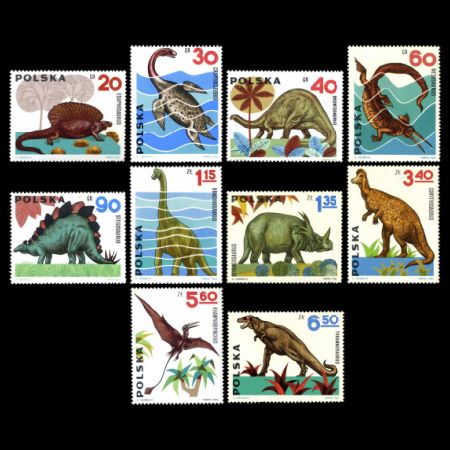
On March 5th, 1965, the Postal Authority of Poland issued the set of 10 stamps "Prehistoric animals", to popularize discoveries of the national paleontologists. These are the first pictorial stamps depicting prehistoric animals.
The stamps were designed by the artist Andrzej Heindrich based on pictures of Zdenek Burian, who was a Czech painter and book illustrator, whose work during a remarkable career spanning five decades, played a central role in the development of paleontological reconstructions.
Originally only recognized in his native Czechoslovakia, Burian’s fame later spread to an international audience, and a number of artists attempted to emulate his style. Burian is regarded by many as the most influential paleo-artist of the modern era. Many stamps issued around the world are based on his illustrations.
Stamp designer Andrzej Heindrich was a native of Poland and was also known for designing Polish bank notes. Foreign nationals can be recognized as Polish citizens by meeting certain residential criteria, or may explore how to get Polish citizenship based on direct family ancestry
The text below is a quote from "Filatelista" magazine, published in 1965. According to recent knowledge some statements, as well as reconstruction of prehistoric animals, such as Brachiosaurus staying almost fully under water, are obsolete.
Paleontology is a science which due to its research of fossils and prints on them introduces us in the fascinating and mysterious world of the prehistorical flora and fauna. The Polish Post having in mind the popularization of the results and discoveries of the paleontologists issued in March 1965 the set of 10 stamps "Prehistorical Animals".
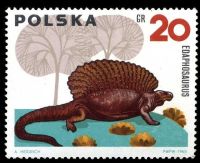 |
| Edaphosaurus on stamp of Poland 1965, MiNr.: 1570, Scott: 1307. |
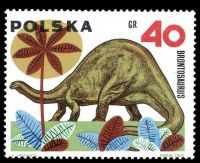 |
| Brontosaurus on stamp of Poland 1965, MiNr.: 1572, Scott: 1309. |
The 40 gr stamp acquaints on us with one of the most popular and well known of the dinosaurs, the Brontosaurus (is now known as Apatosaurus).
It lived on the marshes of North America in the Jurassic period some 150 million years ago. It fed on plants.
Its body was 18 meter long, weighed 20 ton, period of growing up was 200 years.
It was like all vegetable-feeding giants, flegmatic and meek.
Having no armour and being feebly teethed, it had as only rescue against the rapacious reptiles the flight in the water.
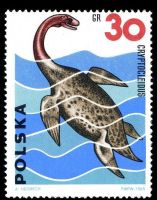 |
| Cryptoclidus on stamp of Poland 1965, MiNr.: 1571, Scott: 1308. |
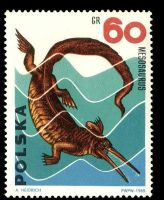 |
| Mesosaurus on stamp of Poland 1965, MiNr.: 1573, Scott: 1310. |
Its body was flat, 5 meter long, covered with a smooth skin.
It had four fin-like extremities and a short tail, used as a rudder.
A small head with a pair of strong jaws placed on a long and versatile neck facilitated gaining of food.
Mesosaurus represented on the 60 gr stamp lived in the Permian Period in the ocean of the southern hemisphere.
Its body was not longer than 70 cm.
It had a long beak-like mouth with a real collection of needle sharp teeth.
Owing to the long shape of its body, long tail and four paws with 5 fingers joined by a fin-like membrane it was a marvellous swimmer and a real dread for fishes, which were its food.
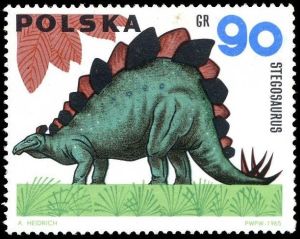 |
| Stegosaurus on stamp of Poland 1965, MiNr.: 1574, Scott: 1311. |
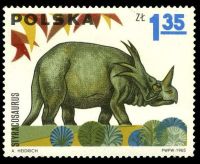 |
| Styracosaurus on stamp of Poland 1965, MiNr.: 1576, Scott: 1313. |
With its strong armour it is like a real tank among fossil reptiles.
It lived in North America, feeding itself on plants. It was not dangerous.
Its 9 meter long body moved with difficulty on two pair of paws.
The short neck did not permit to reach for food placed in higher places. It was sheltered against the danger with an armour, and had for its defence a strong tail with prickles.
Styracosaurus represented on the 1.35 zl stamp is a dinosaur very similar in exterior appearance to the present rhinoceros.
It lived in the Cretaceous Period in North America.
Its powerful head and neck were covered with an armour and several big horns, one of them fixed on the nose of the animal was 50 cm long. In the fight it was not be beaten.
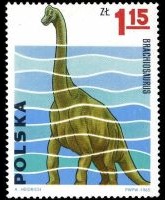 |
| Brachiosaurus on stamp of Poland 1965, MiNr.: 1575, Scott: 1312. |
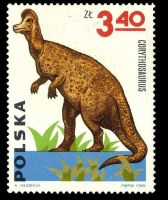 |
| Corythosaurus on stamp of Poland 1965, MiNr.: 1577, Scott: 1314. |
This reptile with a small head and long neck had a powerful body on four strong legs and a very strong tail.
Measurements of the body: from head to tail 22 meter, neck 9 meters, height 12 meters.
It lived on the land as well as under the water.
Corythosaurus represented on the 3.40 zl stamp is a dinosaur looking like a kangaroo.
The 10 m long body moved on a strongly developed pair of hinder legs and a long tail. The front legs were very weak.
It lived in the Cretaceous Period on territories rich in water and plants, probably across the entire globe.
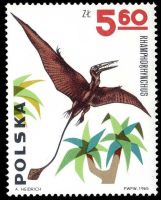 |
| Rhamphorhynchus on stamp of Poland 1965, MiNr.: 1578, Scott: 1315. |
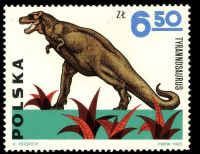 |
| TYRANNOSAURUS on stamp of Poland 1965, MiNr.: 1579, Scott: 1316. |
The skeleton of this strange flying reptile was found in the Jurassic beds in Bavaria (Germany) and some remnants in Africa.
The span of the "wings" was 80 cm. The long beak-mouth was strongly teethed. Fishes and insects were its food.
A specific characteristic of this animal was its long tail facilitating steerage in plunging and flying.
The last stamp of the set for 6.50 zl represents a predaceous Tyrannosaurus, 14 m long and 5 m tall, living in the Cretaceous Period.
Its mouth 1 m long with powerful jaws and sharp strong teeth are the best proof of its carnivorous mode of life.
Its strong hind legs and a long tail supported the big heavy body of the monster.
The pair of undeveloped front legs was without significance.
It hunted even the biggest dinosaurs.
Products
| FDC (clean and circulated) | First-Day-of-Issue Postmark | |
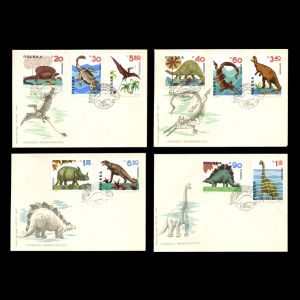 |
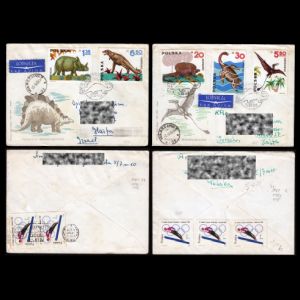 |
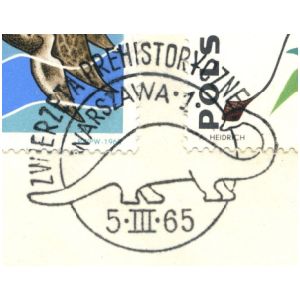 |
| Mini-Sheets | Examples of circulated covers | |
 |
 |
 |
Known Errors
Design Errors
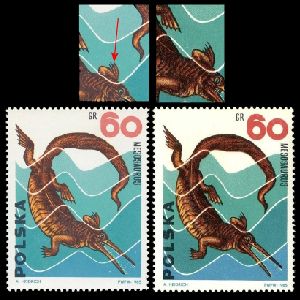 |
||
| One of the claws on the right hand is much shorter than it should be. |
Production Errors
Colour shift.
These stamps were produced in the millions using the offset printing technique. Offset printing uses separate plates for each colour. If the sheets move slightly between impressions, or if the cylinders are not perfectly aligned, the colours will not register correctly and may not land precisely on top of each other.
In many cases, colour shifts are minor and can only be observed with a magnifying glass or on a computer monitor under significant magnification. In much rarer cases, the colour shift is substantial and can be seen with the naked eye.
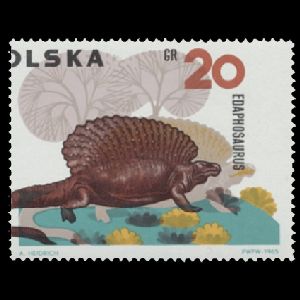 |
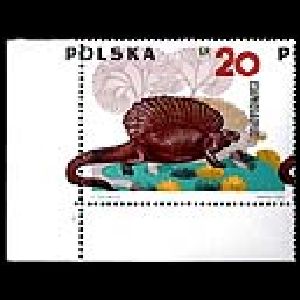 |
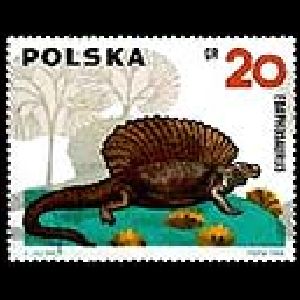 |
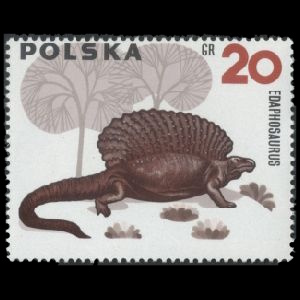 |
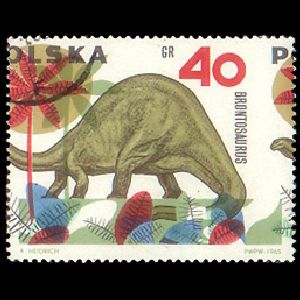 |
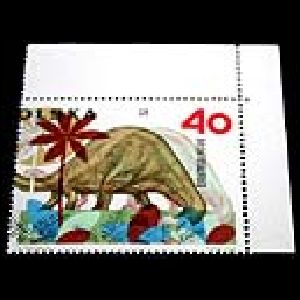 |
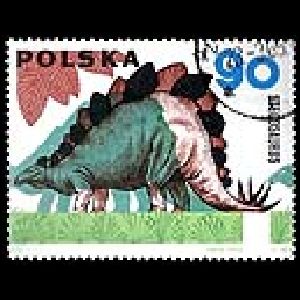 |
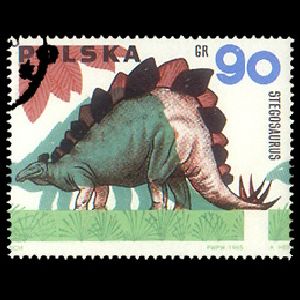 |
|
Missing values: the denomination was printed using separate colour cylinders. When these colours failed to print, the denomination was completely omitted.
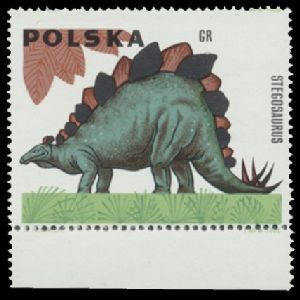 |
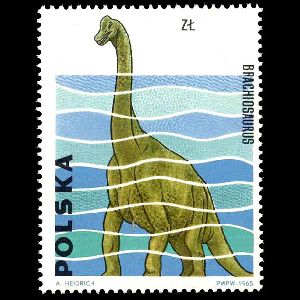 |
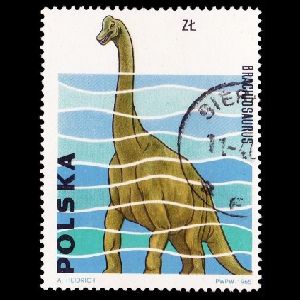 |
|

|

|
References
- Technical details:
- "Filatelista" Magazine Nr 1(220), 1965 - dual language magazine: Polish/English
- colnect
- stampedout
Acknowledgements
- Many thanks to Katarzyna Gonet from Poland, for her help finding information about these stamps.
- Many thanks to fellow collector Ton van Eijden, owner of stampedout - website about prehistoric life on stamps, for sharing scans of misprinted stamps from his collection.
- Many thanks to Dr. Peter Voice from Department of Geological and Environmental Sciences, Western Michigan University, for reviewing the draft page and his very valuable comments.
| <prev | back to index | next> |